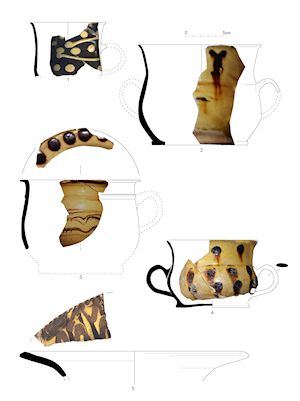
1. Bristol slipware cup with reversed colouring, context 1145; 2. Bristol slipware handled bowl, context 1046; 3. Bristol slipware chamber pot, context 1046; 4. Bristol slipware cup, context 1094; 5. Bristol slipware dish, context 1046.
Cite this as: Gutiérrez, A. The Pottery Analysis in N. Corcos et al. Excavations in 2014 at Wade Street, Bristol - a documentary and archaeological analysis, Internet Archaeology 45. https://doi.org/10.11141/ia.45.3.2
This study follows a preliminary assessment of the material from excavation carried out in October 2014 (Gutiérrez 2014) and now includes the ceramics recovered from the watching brief. The assessment was carried out without reference to the stratigraphy, which was not available at the time. The assessment recommended that the pottery was studied fully once the phasing was complete in order to interpret the results in conjunction with the history of the site. To date, however, the phasing remains unresolved given that the stratigraphy of the site is both complex and shallow; interpretation of the ceramics data remains inevitably general and limited in this respect.
The quantity of ceramics recovered during the archaeological investigations in Wade Street was 1,325 sherds, weighing 3.61kg. Most of this was found during the excavation. There were also 110 fragments of modern ceramic building material (9.8kg). Only a very small assemblage was found during the watching brief (28 sherds; 2.1kg).
The ceramics were sorted into fabrics and types by eye; they were then counted and weighed. Remarkably, most of the material (98% by sherd count) dates to the 18th century. The lack of earlier wares appears to confirm that there was no occupation in this area prior to that date. A handful of medieval sherds was also found but they seem to have been redeposited. A detailed quantification of pottery types by context is available in the archive.
The ceramic assemblage is dominated by household items. Although they are very fragmented, several profiles can be reconstructed and these have been illustrated. A few vessels were found with contents still inside, and these were analysed in order to identify the residues. Only a small group of pottery is unstratified (54 sherds; 1kg).
| Name | Fabric | Date | Sherd count | Sherd % | Weight (g) | Weight % |
|---|---|---|---|---|---|---|
| Excavation | ||||||
| Bristol ware | BPT67 | Mid-13th-15thC | 5 | 33.3 | 14 | 13.3 |
| Ham Green coarsewares | BPT32 | 12th-13thC | 2 | 13.3 | 6 | 5.7 |
| NW Wiltshire | BPT18 | 13th-14thC | 3 | 20.0 | 20 | 19.0 |
| Ham Green glazed jugs | BPT26 | 12th-13thC | 1 | 6.7 | 48 | 45.7 |
| Bath A coarsewares | BPT46 | 12th-13thC | 2 | 13.3 | 6 | 5.7 |
| South Somerset late medieval glazed | BPT124 | 15th-16thC | 1 | 6.7 | 2 | 1.9 |
| wares | ||||||
| Malvern wares | BPT168 | 14th-16thC | 1 | 6.7 | 9 | 8.6 |
| Total | 15 | 100 | 105 | 100 | ||
The medieval pottery comprises local types and others frequently found in excavations around the city (Table 7). The main fabrics are as follows:
Ham Green coarsewares (BPT32). Bristol. 12th−13th centuries (Vince 1988, 258). Red or black throughout with red surfaces. Abundant sub-angular quartz <0.2mm; moderate rounded mudstone <1mm, grey, pink or red; sparse calcareous grains <0.5mm. Hand-made jars.
Ham Green jugs (BPT26). Bristol. 12th−13th centuries (Barton 1963; Ponsford 1991). Grey core; buff or white margins; pink, orange or buff interior surface. Inclusions of well-sorted quartz, limestone and clay pellets of varying sorting and size. Hand-made jugs, finished on a slow wheel. Green glaze on exterior surface and over the interior of the rim only.
Bristol (/Redcliffe) ware (BPT67). Bristol. Mid-13th to 15th centuries (Vince 1988, 260; Ponsford 1998). Usually pale yellow or pink throughout, sometimes with a light grey core. Inclusions of quartz <1.2mm, clay pellets <1mm, occasional sandstone up to 7mm, iron ore 0.2mm across, rounded limestone <0.3mm. Wheel-thrown jugs. Green glaze on exterior.
Bath A (BPT 46). Avon Valley-West Wiltshire? Late 11th–13th centuries (Vince 1979). Usually grey core, buff margins and grey surfaces. Abundant mica, rare calcareous inclusions, moderate flint/chert <3mm, clay pellets, moderate glassy quartz <2mm. Smoothed-over surfaces. Hand-made jars. Occasional combing on exterior surface and green glaze.
North-west Wiltshire (Minety-type ware) (BPT 18). 12th–15th centuries (Vince 1988, 262). Grey core and white or buff surfaces. The main inclusion is abundant oolitic limestone, which leaves a characteristic round void when burnt out during firing. All inclusions are ill-sorted and mainly <1mm, but also up to 2mm. Hand-made (12th−13th centuries) and wheel-thrown (14th−15th centuries) jars and jugs. Occasional exterior green glaze.
Malvern Chase medieval and late medieval ware (BPT 168, BPT 197). Worcestershire. 14th−16th centuries (Vince 1977; Shoesmith 1985). Orange/pink throughout. Occasional inclusions of granite of varying sizes, usually 2−3mm, but up to 8mm across; moderate quartz. Transparent partial glaze, usually with dark green spots in earlier wares; later (mid-16th century onwards) production glazed in brown. Hand-made (earlier wares) and wheel-made wares. Late medieval Somerset (BPT124). Somerset, transitional medieval to post-medieval (Gutiérrez 2007a). Orange throughout, but occasionally pinkish or grey core. Sandy texture with no inclusions visible, except for occasional rounded quartz. Exterior glaze only.
A total of 15 medieval sherds weighing just over 100g were recovered. Most of these sherds are residual and mixed with material of modern date (contexts 1089, 1106, 1123, 1158). Some of them are also very worn, suggesting that they have been redeposited.
A range of fabrics and types were identified and these have been matched as far as possible with the reference collection from Bristol (Bristol Pottery Type or BPT). The main fabrics are as follows.
Bristol (/Staffordshire) slipwares (BPT100). Late 17th−18th centuries. Buff throughout. Moderate iron oxide, <0.25mm, is present. Trailed dark brown slip over white slip under amber glaze.
English delftware (BPT99). Late 17th-18th centuries. No inclusions visible; fine light cream, white or light orange fabrics. All-over white tin glazed, undecorated and plain or with painted decoration.
Modern red earthenwares (BPT336). 18th-19th centuries (Jackson 2002a). Hard, red or brown fabric. Occasional quartz and limestone inclusions. Honey or brown lead glazed, sometimes mottled.
North Devon gravel-tempered wares: gravel-tempered (BPT112) and sgraffito (BPT108). Late 17th-18th century (Allan 1984). Grey or orange core, grey interior margin and surface, orange exterior margin and surface. Super abundant quartz <6mm; abundant milky quartz up to 3mm; sparse limestone up to 2mm; moderate slate <5mm; moderate chert <6mm. Green glaze on interior surface.
Mottled ware (BPT211). Bristol? 18th century. Very fine buff fabric, with overall mottled brown glaze. Wheel-made.
South Somerset glazed wares (BPT124). 17th-18th centuries (Coleman-Smith and Pearson 1988; Gutiérrez 2007a). Generally orange throughout, but occasionally with grey core or surfaces. No visible inclusions. Wheel-made. Included in this group are plain lead glazed wares, all-over white slipwares and sgraffito wares.
Bridgwater-type slipwares (BPT263). 18th-19th centuries (Boore and Pearson 2010). Wheel-made glazed redwares of fine fabric and thick walls decorated with concentric white slip lines.
Refined wares: creamware (BPT326), pearlware (BPT202), white salt-glazed stoneware (BPT179), blackwares (BPT311), agate wares (BPT347), plain dipped white stoneware (BPT179) and porcelain (BPT203).
Nottingham-type stonewares (BPT212). Nottingham/Derbyshire, 18th century.
Modern grey/brown stonewares. Included here are lead-glazed wares (Bristol-type; BPT277) and also glazed stonewares of the 19th century.
Westerwald stoneware (BPT95). Germany. 17th-18th centuries (Gaimster 1997). Characteristic blue and grey salt glaze, incised and moulded decoration over the fine, pale grey fabric.
A total of 1196 sherds (25.1kg) of modern pottery were present. The major groups, comprising 70% of all the sherds (or 75% of the weight) recovered, are Bristol slipwares, delftwares (white tin-glazed), modern redwares, North Devon gravel-tempered wares, brown mottled wares and creamwares. The rest of the fabrics and types are represented only in small quantities and sometimes as single sherds (Table 8).
| Name | Fabric | Group | Date | Sherd count | Sherd % | Weight (g) | Weight % |
|---|---|---|---|---|---|---|---|
| Excavation | |||||||
| Bristol slipwares | BPT100 | earthenware | late 17th-18thC | 243 | 20.1 | 4974 | 19.7 |
| Delft or tin-glazed wares | BPT99 | tin glazed | 18thC | 169 | 14 | 1678 | 6.6 |
| Modern redwares | BPT336 | earthenware | 18th-19thC | 154 | 12.7 | 5886 | 23.3 |
| North Devon gravel-tempered | BPT112 | earthenware | late 17th−18thC | 146 | 12.1 | 4934 | 19.5 |
| wares | |||||||
| Mottled ware | BPT211 | earthenware | 18thC | 142 | 11.7 | 1600 | 6.3 |
| Creamware | BPT326 | creamware | 18thC | 112 | 9.2 | 1042 | 4.1 |
| Modern brown stoneware | BPT277 | stoneware | late 17th-18th | 56 | 4.6 | 1612 | 6.4 |
| Plain dipped white stoneware | BPT179 | stoneware | 18thC | 46 | 3.8 | 529 | 2.1 |
| South Somerset unglazed wares | BPT124 | earthenware | 18thC | 40 | 3.3 | 1369 | 5.4 |
| Pearlware | BPT202 | pearlware | 1790s+ | 23 | 1.9 | 211 | 0.8 |
| Westerwald stoneware | BPT95 | stoneware | late 17th-18thC | 14 | 1.2 | 287 | 1.1 |
| South Somerset glazed wares | BPT124 | earthenware | 18thC | 14 | 1.2 | 189 | 0.7 |
| White stoneware | BPT179 | stoneware | 18thC | 8 | 0.7 | 113 | 0.4 |
| Modern porcelain | BPT203 | porcelain | late 18th-19thC | 5 | 0.4 | 32 | 0.1 |
| Modern yellow glazed ware | BPT-- | earthenware | 19thC+ | 4 | 0.3 | 419 | 1.7 |
| Chinese porcelain | BPT-- | porcelain | 18thC | 4 | 0.3 | 35 | 0.1 |
| Blackware | BPT311 | earthenware | 18thC | 3 | 0.2 | 153 | 0.6 |
| Modern slipped stoneware | BPT179 | stoneware | 18thC | 3 | 0.2 | 27 | 0.1 |
| Nottingham-type stoneware | BPT212 | stoneware | end 17th-19thC | 3 | 0.2 | 17 | 0.1 |
| Modern yellow ware | BPT-- | stoneware | 19thC | 2 | 0.2 | 36 | 0.1 |
| Scratch-blue stoneware | BPT179 | stoneware | 18thC | 2 | 0.2 | 27 | 0.1 |
| North Devon sgraffito | BPT108 | earthenware | late 17th-18thC | 1 | 0.1 | 12 | 0 |
| Bridgwater-type slipware | BPT263 | earthenware | 18th-19thC | 1 | 0.1 | 6 | 0 |
| Agate ware | BPT347 | agate | 18thC | 1 | 0.1 | 5 | 0 |
| Total | 1196 | 100 | 25193 | 100 | |||
| Watching brief | |||||||
| Bristol slipwares | BPT100 | earthenware | late 17th-18thC | 9 | 32.1 | 472 | 22.2 |
| Westerwald stoneware | BPT95 | stoneware | late 17th-18thC | 7 | 25.0 | 218 | 10.2 |
| Delft or tin-glazed wares | BPT99 | tin glazed | 18thC | 4 | 14.3 | 54 | 2.5 |
| Modern yellow ware | BPT-- | stoneware | 19thC | 4 | 14.3 | 419 | 19.7 |
| Modern redwares | BPT336 | earthenware | 18thC-19thC | 1 | 3.6 | 68 | 3.2 |
| Mottled ware | BPT211 | earthenware | 18thC | 1 | 3.6 | 8 | 0.4 |
| Modern white porcelain | BPT-- | porcelain | 18thC | 1 | 3.6 | 8 | 0.4 |
| Bristol lead glazed stoneware | BPT277 | stoneware | 19thC | 1 | 3.6 | 883 | 41.5 |
| Total | 28 | 100 | 2130 | 100 | |||
Note: retrospective application of site phasing to the ceramic evidence, at least at a high level of detail, is unfortunately not possible at present. This is because, in many cases, the dating of the fabrics is simply too coarse, and spans far too great a date range for them to be useful for this specific purpose.
The pearlwares are the latest pottery on the site and date mainly to the 19th century. They include late types, such as the black-printed wares of the 1790s (context 1060), and the green-printed wares of the 1820s onwards (context 1164). Among the latter is a rectangular base (probably belonging to a gravy boat) with a green stamp on the underside reading 'Sicilian' in a scrolled cartouche; this is a pattern used by Pountney and Allies in Bristol, but also by Milton and another unidentified maker (Coysh and Henrywood 1993, 338; Neale 2005, 122).
Modern porcelain of the 19th century was found in very small quantities (contexts 1009, 1088, 1164); a 19th-century modern yellow ware was also identified (context 1123).

The rest of the assemblage is more firmly dated to the 18th century, with characteristic local products of lead glazed earthenwares, yellow slipwares, mottled wares, and North Devon and South Somerset products. The yellow slipwares are by far the most frequent fabric (Nos 1-7); one-third are press-moulded dishes and two-thirds are cups, porringers and mugs; a single chamber pot was also identified (Figure 45, No. 3). The dishes have the characteristic pie-crust rim (No. 5). They all have in common a light cream fabric with the trailed dark brown slip over cream background, and only a couple of dishes and a cup have reversed colouring (Figure 45, No. 1). An almost complete lid (for a cup or porringer) was also found in context WB 184 (similar to that illustrated in Barton 1961, fig.2, no. 8). A dish fragment had been trimmed to a semi-rectangular shape (Figure 46, No. 7). Nine sherds were decorated with a complex moulded and rouletted decoration. Five of these were found in context 1145 and they belong to a square dish; there were no joins with the rest of the sherds (contexts 1146, 1090, 1178, u/s) and it is likely that they represent different vessels. The pattern on this square dish perhaps illustrates a lion, although not enough survives to permit a confident identification of the overall theme (Figure 46, No. 6).
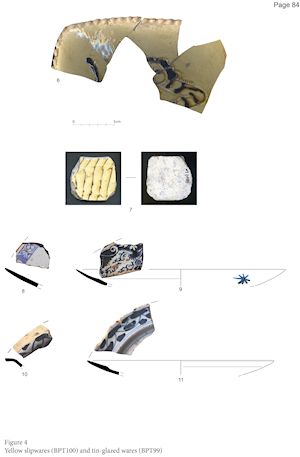
There is a good range of decorated tin-glazed wares, presumably from Bristol, although most vessels are very fragmented and small. A selection of diagnostic sherds is illustrated here (Figures 46 and 47, Nos 8-22). Most of the tin-glazed wares are either plain or decorated only in blue. Just a couple of vessels bear polychrome decoration: two sherds from a single vessel are decorated in orange, green and blue, in an early 18th-century style (Figure 47, No. 19). The forms include plates, dishes and bowls. A couple of vessels are of early type, with an opaque white, tin-glazed interior surface and a yellowish lead-glaze back; these were either produced in England or in the Netherlands. Both are chargers or large plates, that from context 1106 is decorated with blue and purple, that from 1086 with blue and green.
Fifteen sherds of delftware drug jars decorated with blue lines could all belong to just a couple of vessels (Figure 47, Nos 20-22) although they appear spread across several contexts (1046, 1091, 1145 and 1190). Most of these are make-up layers where sherds could have been redeposited, but 1145 is the fill of a rubbish pit and it may be contemporary with the discarding of the pot.
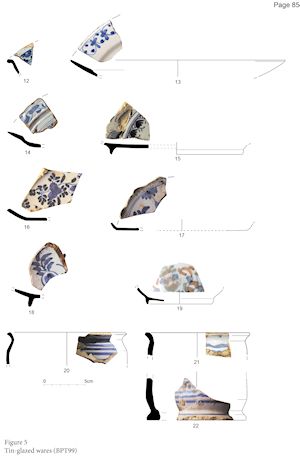
Among the refined earthenwares, plain creamwares (1740-1800s) dominate the assemblage (Figure 48, Nos 23-26). They are accompanied by smaller quantities of blackwares, agate wares, and also stonewares, both white and brown (Figure 48, Nos 29-31).
The only imported pottery is the Westerwald stoneware from Germany. Twenty-one sherds were recovered, all similarly decorated with the typical incised and moulded decoration, using only blue colour. Sadly there are no crossfits and given the uniformity of forms produced it is not possible to calculate how many vessels the sherds might represent. Five fragments belong to a single jug decorated with a central medallion encircling initials (now lost), surrounded by flowers, ribbons and birds (Figure 48, No. 27). The most frequent initials found on this type of vessel are GR and stand for King George I (1714-1727) or George II (1727-1760) (Gaimster 1997, 268). The jug is unstratified, being found during the watching brief (context 100). The sherds appear across contexts 1000, 1090, 1091, 1114, 1138, 1164 and 1198; they are mostly make-up or levelling layers, where the sherds would have been redeposited.
A Staffordshire scratch-blue mug in salt-glazed stoneware is decorated in imitation of Westerwald stoneware (Mountford 1971). The mug has a similar medallion and in this case the initials '[G]R' are clearly visible in relief (Figure 48, No. 28); the mug is from context 1164.
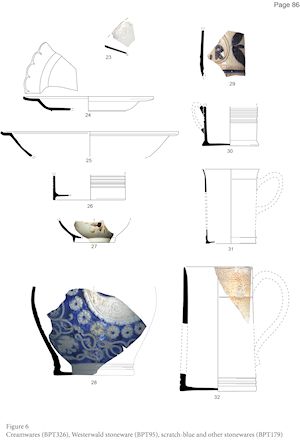
All the pottery recovered is from domestic vessels, such as those required to store, cook and serve foodstuffs at the table. Given the fragmentation of the assemblage it was impossible to identify with certainty all the forms, but bowls, dishes, chargers, jugs and mugs are all present, together with lids, pancheons, drug jugs, chamber pots, flower pots and a colander with a pierced base (context 1009). A possible Bristol slipware candle holder was also recovered from context 1185; together with two square dishes or trays (1145 and WB 100).
Tea wares are rarer. There is a single teapot (blue printed) from context 1123 and a possible teapot lid was found in pit fill 1146; only four tea bowls or cups were identified with any certainty (contexts 1094, 1098 and u/s). Two of them are creamwares, one is a salt-glazed stoneware and only one of them is porcelain.
Flower pots are plain redwares (BPT124, BPT336) with drainholes either on the side, just above the base, or in the centre of the base (Nos 34-36). They seem to concentrate in Area A (24 sherds). One fragment has lost all original surface (context 1046), perhaps indicating long use or redeposition. A single flower-pot dish is 5cm high (context 1114) (Figure 49, No. 37). These garden vessels are similar to profiles from elsewhere in Bristol and Somerset, where they are also dated to the 18th century (Jackson 2006, 180-81; Pearson 1979, 189, figure 2, no. 10).

Only a few vessels showed any signs of having been placed on or near a fire, confirming their use in cooking. Some sherds had been burned throughout, however, and this could relate to some alternative secondary use, though it is more likely they were burnt in the hearth or burnt with refuse (for example, a creamware lid from context 1146).
The local redwares show sooting and burning on the underside (contexts 1009 and 1145); these are glazed wares too fragmented to identify vessel type with any certainty but they appear to be jars/cooking pots. A few Bristol slipwares have similar burning marks on the exterior base (from contexts 1046, 1090, 1114, 1174, 1176 and 1181); these are more delicate vessels traditionally associated with serving, but soot and burning indicate they were also used to heat up foodstuffs, perhaps smaller (individual?) portions, or more delicate dishes, such as sauces and custards, for example.
At least two North Devon gravel-tempered vessels (contexts 1145 and 1168) had also some burning marks. Unsurprisingly, one of them is a handled 'cooking pot' (Allan et al. 2005, figure 18, no. 11A-11B). Besides the burning on the exterior of the walls, this pot had a thin, opaque, white film that covered the whole of its interior surface; this was analysed, proving to be a carbonate (see Appendix 2a, sample AG103), most likely a residue from boiling water or limescale (Figures 50a and 50b ).


Besides these domestic pots, it is also worth noting the presence of unglazed forms that are known in the delftware repertoire, especially a chamber pot from context 1145 (Figure 49, No. 33) and several foot-rings, perhaps from bowls and dishes (in contexts 1009, 1046, 1086, 1114, 1145, 1181 and 1227). These seem to be unfinished pots that have been fired but have yet to receive the white tin glaze that should have covered the whole surface. Finding wasters such as these is, however, a frequent occurrence in Bristol given its numerous and widespread pottery workshops. The closest of these seems to the Water Lane (or Temple Back) pottery, where production of delftwares is documented at least between 1682 and 1784 (Jackson et al. 1982). The potteries here are on the other side of the river, some 2km away from the excavation site.
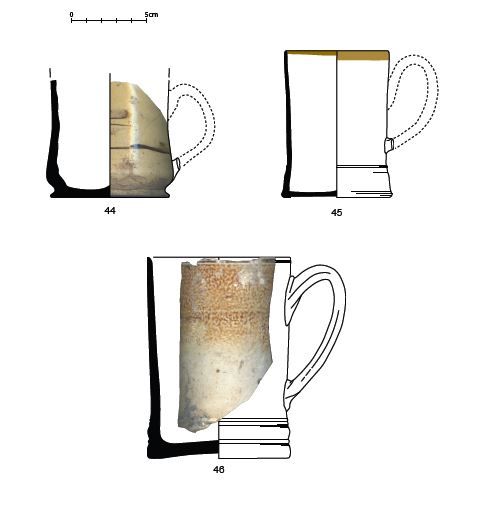
Two other sherds are fragments of sugar moulds (contexts 1114 and 1191). These are typical unglazed local redwares and have been identified due to the smoothed (almost burnished) interior and possible interior slip (dark and white), though they do lack more diagnostic features such as the rim or pierced base. Sugar refineries close by were located in Great George Street, off Wade Street, where Battersby, Hull and Co. are listed in 1711 (Sketchley 1775).
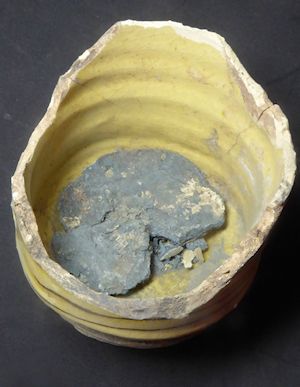
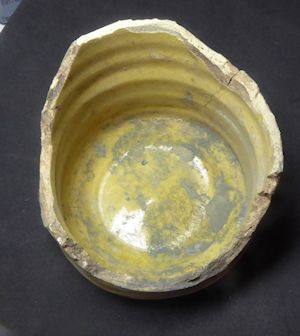
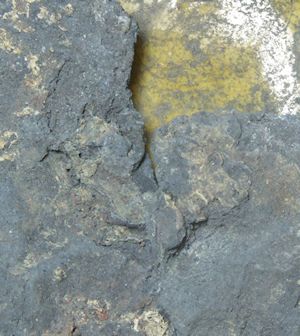
Three vessels from pit fill 1145 were found with their contents still adhering to the interior of the pots (Figures 51–54). This is a remarkable survival and the contents were submitted for analysis. The residues are solidified but soft and powdery (unlike metal residues, which are solid and hard). They include:

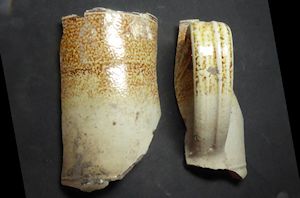
The contents of the first two vessels were clearly a viscous substance that had been stored in the vessels, all of them mugs. The analyses confirm that this substance is almost pure lead (Appendix 2a). In two cases (AG100, AG101) the substance had some colourant added in the form of iron and copper. The residue on the third vessel is a kind of staining that was also observed in smaller quantities on other pots from context 1145 (both on the interior and exterior surfaces of these sherds). Analysis shows that this residue, sample AG102, is also almost pure lead. Taken together, the interpretation of these residues is that at least two mugs were used to store lead paint, possibly one with a yellow (iron) colour, and another with green (copper) tint. They were discarded in a pit (1145) when their contents had not yet been exhausted together with domestic rubbish, mainly domestic pots. Some more lead in liquid form, perhaps stored in a different kind of container, was then thrown into the pit, which would account for the stains on the other pottery sherds.
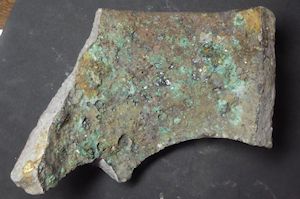

A further sample from a thick glazed half-round tile was also analysed (Figure 55); this residue is copper-green and the analysis confirms this is a metal residue with high copper composition (sample AG104). Although at first glance this resembles residues on crucibles used during the smelting process, in this case, the origin of this residue cannot be ascertained.
The excavation also provided an assemblage of 110 fragments of ceramic building material, weighing 9.8kg. Of this, 104 sherds (9.2kg) are modern pantiles of red clay, with an S-profile, trimmed corner and nib for hanging. They are all very similar in fabric and form. Most brickyards in Somerset that were dedicated to the production of bricks and tiles such as these date to the 18th and 19th centuries (Murless 2000).
The remaining material consists of two undiagnostic brick sherds, a kitchen tile (burnt; context 1160), a glazed half-round tile (with metal residues on the interior surface; sample AG104) and a tin-glazed or delft tile. The delft tile (context 1160) is formed by hand on a bed of sand and decorated in blue with the theme of Jesus and the woman of Samaria at Jacob's Well, and similar tiles have been dated in London to between 1740 and 1760 (Betts and Weinstein 2010, 166, no. 379; see also Archer 1997, 439, no. 48). It would have formed part of a surround to a fireplace (Figure 56).

The ceramic assemblage confirms map and documentary evidence showing that there was no occupation in this part of Bristol before the 18th century. The very few sherds of medieval pottery identified here must derive from elsewhere; quantities are minimal and the sherds are worn, indicating redeposition. It is impossible to establish how they arrived at this site, but they may have been incorporated into the plot through rubbish disposal, stray losses, or manuring of fields prior to the development of this part of the city.
The ceramic assemblage is dominated by 18th-century domestic wares, mainly typical local products from Bristol or nearby from Somerset and North Devon. It is interesting to note the co-existence of local, traditional slipwares and delftwares together with the recently introduced creamwares, a finer type of crockery that was to become the refined choice for serving and consuming food at the table; this would supersede the lead-glazed wares in time. In spite of this, tea wares – a recent introduction in the 18th century – and porcelain are still very scarce and amount to just a handful of sherds.
The identification of mugs holding white lead paint is of interest, but difficult to interpret. Was the paint being used in a domestic setting or as part of a small business? The large oil and colour works located on George Street, just north of the site, are much later and unrelated to this find (19th century; Ordnance Survey 1884, 1:500, First Edition) but a number of professional painters are identified in Bristol during the 18th century, at least two of them in St Philip and Jacob parish in the middle of the century (Poll Book 1754, 84, 96), and another is specifically located in Wade Street by the end of the same century: John Monday (Matthews 1794, 59).
Beyond the common 'painter' a range of specialist painters are also found across the city in the 18th century, including 'painter and glazier', 'portrait painter', 'plasterer and painter', 'house and sign painter', 'painter and floor-cloth manufacturer' and 'miniature painter'. Remarkably, pottery and porcelain decorators are not always identified as such through these records, although we know of their trade. It is clear that painters could move from one branch of the craft to another, depending on the fortunes of their business; porcelain decorators, for example, went on to become miniature painters and enamellers when they needed the work (Owen 1873, 200).
White lead was a durable pigment widely used in the 18th century until zinc white was invented at the end of that century (Tallian 2009, 74). Lead white has a wide range of applications: in the manufacture of exterior house paint; as a primer on wood surfaces prior to painting, both for domestic use and on sculptures; as an ingredient in palette decorative paints, to name but a few (Aliatis et al. 2012; Lloyds 1875, 12, 73).
Any of the crafts listed above could have used white lead in their trade, but no business directly related to any of them is listed in the area in the main trade directories of the time, except for the above-mentioned John Monday. He lived surrounded by a butcher, skinner, tailor and a couple of pubs on Wade Street, and by a baker, 'mealman', and maltster, together with another two pubs on Little Anne Street (Matthews 1794).
The pottery was found in pit fill 1145, where some of the unfinished delftwares were also found. Sadly, we cannot confirm for certain if these pots belonged to John Monday or if he was involved in the manufacture or decorating of delftwares; painters of pots were supposed to work at the potteries, but the presence of both lead and unglazed pots in this part of the city is intriguing.
Internet Archaeology is an open access journal based in the Department of Archaeology, University of York. Except where otherwise noted, content from this work may be used under the terms of the Creative Commons Attribution 3.0 (CC BY) Unported licence, which permits unrestricted use, distribution, and reproduction in any medium, provided that attribution to the author(s), the title of the work, the Internet Archaeology journal and the relevant URL/DOI are given.
Terms and Conditions | Legal Statements | Privacy Policy | Cookies Policy | Citing Internet Archaeology
Internet Archaeology content is preserved for the long term with the Archaeology Data Service. Help sustain and support open access publication by donating to our Open Access Archaeology Fund.